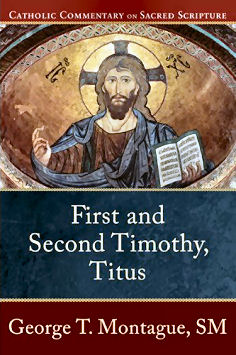
|
Posted June 16, 2010
Book: First and Second Timothy, Titus Author: George T. Montague, SM Baker Academic, Grand Rapids, MI. 2008. Pp. 267 Excerpt from Introduction:
Timothy is Paul’s number one collaborator. The Acts of the Apostles tells us that on Paul’s second missionary journey he recruited young Timothy from his native town of Lystra, in Asia Minor, and thereafter the two were rarely separated. We often think of Paul as single-handedly converting Asia Minor and Greece, like a Lone Ranger. Not so. It was a team ministry from the start. The apostle mentions Timothy as cosender of six of his letters: 1-2 Thessalonians, 2 Corinthinans, Philippians, Philemon, and Colossians. Three of these letters are written from prison, although we cannot be sure whether Timothy was in prison with Paul when he wrote any of them. In the list of persons who send their greetings with Paul to Rome, Timothy ranks first. Paul sent him on at least two important missions, one to Thessalonica and the other to Corinth. In his plans to send him on a mission to Philippi, he writes, “I have no one comparable to him for genuine interest in whatever concerns you . . .You know his worth, how as a child with a father he served along with me in the cause of the gospel.” Paul imprisoned, it may be about his release from prison the Heb 13:23 refers: “Our brother Timothy has been set free.” More details of Timothy’s life will emerge as the commentary unfolds. But this thumbnail sketch suffices to show that if anyone could be considered Paul’s chief confidant, if anyone could carry on where Paul left off or replace him in his absence and speak with his authority, it would be Timothy, the recipient of this letter. The apostolic Tradition must carry on. An Excerpt from the Book: “Take as your norm the sound words that you heard from me, in the faith and love that are in Christ Jesus. Guard this rich trust with the help of the holy Spirit that dwells within us.” Reflection and Application This section, along with the preceding, provides a precious foundation for the Catholic Church’s understand of Tradition. Whereas the preceding deals with the deposit of the faith as such, this section allows for development in the Tradition. The Second Vatican Council expressed it this way: This tradition, which comes from the Apostles, develops in the Church with the help of the Holy Spirit. For there is a growth in the understanding of the realities and the words which have been handed down. This happens through the contemplation and study made by believers, who treasure these things in their hearts through a penetrating understanding of the spiritual realities which they experience, and through the preaching of those who have received through episcopal succession the sure gift of truth. For as the centuries succeed one another, the Church constantly moves forward toward the fullness of divine truth until the words of God reach their complete fulfillment in her. It is not only the clergy but laypeople who are bearers of the Tradition. Even as the parent teaches the child the sign of the cross, he or she is guarding and handing on the Tradition. Although it is important to know and understand what God has revealed, this Tradition is not preserved by mere study. One cannot understand the things that have been given us by God without the Holy Spirit. Table of Contents: The First Letter to Timothy Timothy’s first charge Liturgy and conduct Qualifications of ministers False teaching and advice to Timothy Rules for different groups Final directives: slaves, truth, riches The Second Letter to Timothy Timothy’s gifts and Paul’s lot Counsels to Timothy Meeting the challenges of the last days Final charge to Timothy and Paul’s faith amid his loneliness The Letter to Titus Organizing the church in Crete Virtues for different states of life How we should live |
|
